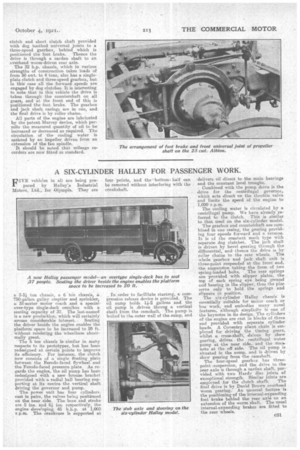A SIX-CYLINDER HALLEY FOR PASSENGER WORK.
Page 19

If you've noticed an error in this article please click here to report it so we can fix it.
FIVE vehicles in all are being prepared by Halley's Industrial Motors, Ltd., for Olympia. They are
a 3-3k ton chassis, a 6 ton chassis, a 750-gallon galley emptier and sprinkler,
32-"water motor coach and a specialover-type single-deck omnibus with 3 seating capacity of 37. The last-named is a new production, which will certainly
amuse considerable interest. Seating the driver beside the engine enables the platform space to be increased to 26 ft. without rendering the wheelbase abnormally great.
The 6 ton chassis fa similar in many respects to its prototypes, but has been redesigned at certain points to improve its efficiency. For instance, the clutch now consists of a 'single floating plate between the Ferodo-faced flywheel and the Ferodo-faced pressure plate. As regards the engine, the oil pump has been redesigned with a, new bronze bracket provided with a radial ball bearing supporting at its centre the vertical shaft driving the governor and pump. The power unit has four cylinders. cast in pairs, the valves being positioned on the near side. The, bore and stroke are 5 ins. and 61 ins. respectively, the engine developing 45 bl.p. at 1,000 r.p.nn. The crankcase is supported at
four points, and the ..bottom.i half can be remo'ved without interfering with the era nkshaft.
In order to facilitate starting, a compression release device is provided. The oil sump holds 4-2 gallons and the oil pump is driven throng a vertical shaft from the camshaft. The pump is bolted to the outer wall of the sump, and .delivers oil direct to the main bearings and the constant level troughs. Combined With the pump drive is the drive for the centrifugal governor, which acts direct on the throttle valve and limits the speed of the engine to 1,000 r.p.m.
The cooling water is circulated by a centrifugal pump. We have already referred to the Clutch. This is similar to that used on the six-cylinder model.
The gearbox and countershaft are com bined bined n one casing, the gearing providing four speeds forward and a reverse. It is of the constant mesh type with separate dog clutches. The jack shaft is driven by bevel .gearing through the differential, and thence the drive is by roller chains to the rear wheels. The whole gearbox and jack shaft unit is three-point suspended at the front end, the suspension taking the form of two spring-loaded bolts. The rear springs are provided with slipper plates, the top of each spring eye being ground and bearing in the slipper, thus the pins serve only to hold the springs and slippers in position.
The six-cylinder Halley chassis is essentially suitable for motor coach or bus work, and embodies many novel features, although simplicity is one of the keynotes in its design. The cylinders of the engine are cast in blocks of three and provided with separate cylinder heads. A Coventry silent chain is employed for driving the timing gears, whilst a cross-shaft, driven by skew gearing, drives the centrifugal water pump at the near side._ and the -ma.* neto at the off side. The oil pump is situated in the sump, and is driven by skew gearing from the camshaft. The four-speed gearbox has threepoint 'suspension, and the drive to the rear axle is through a cardan shaft, pro,videcl with two -Hardy disc joints of exceptional strength. 'Similar joints are
employed for the clutch shaft. The final drive is by David Brown overhead worm gearing. An unusual feature is the positioning of the internal-expanding foot brake behind the rear axle on an extension of the worm shaft. The usual internal-expanding brakes are fitted to the rear wheels.
















































